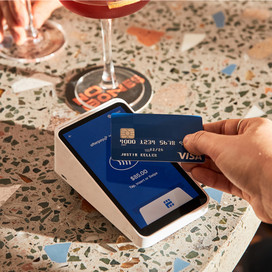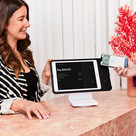Table of contents
Embarking on a new commercial venture is exciting, but whilst getting on with the business of selling is at the front of your mind, you need to make sure you’re collecting the right taxes too.
What is the goods and services tax (GST)?
Goods and services tax (GST) is a general tax which is added to most products and services sold or consumed in Australia. There are some products which are exempt, called GST-free sales.
If you run a business, and provided you meet certain thresholds, you’ll collect tax on behalf of the Australian Taxation Office (ATO). The government then uses the money raised to fund public services, infrastructure projects, schools, hospitals etc.
The tax was introduced in 2000 to overhaul and simplify the existing tax system. It did away with many state and territory levies, replacing it with one single, easier-to-understand tax.
How much is GST?
GST is currently 10%. It’s worth checking regularly with the Australian Taxation Office (ATO) as the government has the power to raise or lower it.
How does GST work?
Not every business needs to register for GST; there are certain conditions which must apply such as passing the turnover threshold. However, the threshold is relatively low so it’s likely your business will be subject to GST obligations at some point.
The conditions are:
- Your business has a turnover of more than $75,000
- Your business is a not-for-profit organisation with a turnover of more than $150,000
- You intend to claim for fuel tax credits (GST applies regardless of turnover)
- You provide limousine or taxi travel (GST applies regardless of turnover)
- Overseas retailers who have an Australian sales turnover of $75,000 or more
If you don’t register for GST, you could be in trouble and risk facing some hefty tax bills as well as penalties.
Do I need to register my business for GST?
If you meet one of the conditions above, you’ll need to register for GST. If your turnover is below the threshold, you’re not legally obliged to register but you can do so if you want to.
You must register when:
- You have a turnover (gross income from all business activities minus GST) which exceeds $75,000 ($150,000 for non-profits).
- You’ve started a new business but expect turnover to exceed the threshold in the first year of operation.
- You’ve already passed the threshold.
- You’re offering a limousine or taxi service for a fare.
- You wish to claim fuel tax credits in your business.
If you’re not sure when you’ll exceed the relevant threshold, check your turnover monthly, because once you go over, you only have 21 days to register. The Government provides further information on how to work out your GST turnover, but you may find using accounting software can help you simplify the process.
If you’re registered for GST, you can claim back GST on any goods and services you buy in the course of running your business; just remember to get a tax invoice at the time of purchase.
How do I register for GST?
Before registering for GST, you need an Australian Business Number (ABN). You apply for an ABN when you first register your business name or later on.
Once you’ve got an ABN, you can register for GST in several ways:
- Online through the ATO business portal
- By phone on 13 28 66
- Through a registered tax agent
- Using Add New Business Account Form (N2954). (Order it here)
It’s a straightforward process and you only need to do it once, even if you run more than one business.
What do I need to do after registering for GST?
The ATO send you details of your GST registration, including the date when it becomes effective. They also send your ABN details if you’ve not already received them.
Your customers now need to pay the cost of goods or services plus 10% GST. You need to:
- Include GST in the price of your products or services.
- Claim credits for GST on products or services you purchase to run your business.
You need to send the 10% GST amount to the ATO. The frequency of this depends on your turnover.
What products or services are exempt from GST?
There is a whole range of GST-free goods and services. The main ones are most basic food, some education materials or courses, some medical and healthcare services, some menstrual products, some medicines and some childcare services. The ATO has a full list of exemptions including a detailed food exemption list and comprehensive information on other exemptions.
Are exports exempt from GST?
It depends on when the goods are exported and whether certain conditions are fulfilled. Goods are GST-free if they’re exported within 60 days of one of the following occurring:
- The supplier is paid for the goods
- The supplier issues an invoice for the goods
You can apply to the ATO to extend the 60-day period. If the payment of goods is by instalment, the payment or invoice must be for the final instalment.
Supply of anything other than goods or tangible property abroad, such as professional services, consulting etc, are also GST-free if the recipient is outside of Australia.
Do I need to pay GST on imported goods?
You have to pay GST on most imported goods unless they’re covered by an exemption.
If you’re not registered for GST, you still have to pay it on goods you bring into the country. If you are registered for it, however, you may be able to claim GST credit on any of the goods you import that are used as part of your normal business activity.
GST on imported goods is collected by the Department of Home Affairs and is 10% of the taxable importation value. The taxable importation is made up of:
- The customs value of the goods
- Any customs duty payable
- The amount paid to transport the goods to Australia and the cost of insuring them
- Any wine tax payable
You usually need to pay the GST before the goods are released. However, this can be deferred if you are part of the deferred GST scheme.
How do I pay GST to the ATO?
Pay your GST and claim any GST credits by sending to the ATO an annual GST return, or by lodging a Business Activity Statement (BAS). Once you’re registered for GST, the ATO sends you a BAS around two weeks before the end of your reporting period which is usually every three months. This statement shows the date for lodging and any payment that needs to be made. However, the rate at which you need to pay varies according to your turnover.
- More than $20 million – If your turnover is more than $20 million, report and pay every month using the full reporting method.
- Under $20 million – You can still complete the BAS monthly if it’s more advantageous for cash flow purposes, but you can choose to use the full reporting method, or the BAS reporting method if your turnover is under $10 million. Otherwise, do it quarterly.
Pay your GST through the ATO’s online portal using BPAY, or a credit or debit card. You can also pay by phone on 1300 898 089, electronic transfer or in person at Australia Post.
If you wish, you can make voluntary early payments to offset any future BAS liability.
What’s the simpler BAS reporting method?
The simpler BAS reporting method allows you to still report and pay monthly, and is the default method for businesses with a turnover of less than $10 million.
It means you needn’t complete a GST calculation worksheet and you needn’t give as much information.
What’s the full reporting method?
The full reporting method is for businesses with a turnover of $10 million or more, and there is specific information you need to report each month to the ATO:
- Total sales
- Export sales
- Other GST-free sales
- Capital purchases
- Non-capital purchases
- GST on sales
- GST on purchases
What’s the GST instalments method?
The GST instalments method means you pay a quarterly amount calculated by the ATO, then report the actual GST amounts on your annual return.
It applies to businesses with a GST turnover of $10 million or less and the amount you owe is based upon your most recent net GST amounts you’ve reported.
When is my BAS due?
The dates for lodging your BAS are on the statement the ATO sends you. Send it monthly if turnover is more than $20 million, quarterly if your turnover is less than $20 million and the ATO hasn’t told you to report monthly, and annually if your turnover is less than $75,000 ($150,000 non-profit) and you’ve voluntarily registered for GST.
If you lodge your BAS quarterly, do it by the 28th day of the month following the end of a financial quarter (except quarter 2 which is two months after):
- Quarter 1 – July, August, September – 28 October
- Quarter 2 – October, November, December – 28 February
- Quarter 3 – January, February, March – 28 April
- Quarter 4 – April, May, June – 28 July
If you file it monthly, you should send it in no more than 21 days after the end of each month.
Can I change my GST reporting and payment cycle?
You can change your GST reporting cycle if there are changes in your circumstances such as an income increase or drop. Depending on when you request a change, either commence the new cycle straightaway or wait until the new quarter or financial year.
Can I lodge my BAS early?
Only lodge a statement early when you’re going to be absent from your business during the reporting period and your business won’t be trading in that period.
What is luxury car tax (LCT)?
Luxury car tax (LCT) is a tax on prestige cars – cars with a GST inclusive price which is above the threshold set by the ATO.
It’s a tax usually paid by businesses which sell or import luxury cars and can add significant cost to the purchase of some vehicles. The current tax rate is 33%, meaning you pay an extra 33% on the GST-inclusive value which exceeds the threshold; you don’t pay it on the entire amount of the car. The current tax thresholds for 2022–23 are $84,916 for fuel-efficient vehicles and $71,849 for other vehicles, so any car that is sold above that amount will be subject to 33% LCT on the amount that exceeds those thresholds.
What is wine equalisation tax (WET)?
Anyone who makes wine, imports it into Australia or sells it wholesale will have to account for wine equalisation tax of 29%. It’s a tax on the wholesale value of wine which usually has to be paid if you’re registered for GST or you need to be registered for GST. It’s also payable on all imported wine whether you’re GST registered or not.
The taxation point for WET is the last wholesale point, usually between the wholesaler and the retailer, so you’d apply WET to the sale price of the wine then calculate GST on that new figure. WET must also be reported on your BAS.
What are fuel tax credits?
If you use fuel for your machinery, plant equipment, heavy vehicles or light vehicles used on private and public roads, you may be able to apply for fuel tax credits. This allowance gives businesses a credit for the fuel tax that’s included in the price of the fuel purchased.
Eligibility is based upon three areas:
- Eligible business – You must be registered for GST and fuel tax credits. Claim fuel tax credits on your BAS.
- Eligible fuel – Fuel is considered taxable if there is a duty to be paid on it. This includes petrol, diesel, heating oil, kerosene, toluene, liquid petroleum gas (LPG), liquified natural gas (LNG) and compressed natural gas (CNG).
- Eligible activities – Claim fuel tax credits for fuel you use in road transport (vehicles weighing more than 4.5 tonnes), other business uses e.g. agriculture, fishing, forestry, mining, construction, manufacturing, nursing and medical, landscaping, property management, and packaging or supplying fuel.
There are some activities which are ineligible for fuel tax credits. These include:
- Fuels used in light vehicles under 4.5 tonnes such as cars, taxis or small vans
- Gaseous fuels used for heavy vehicles travelling on public roads
- Aviation fuels
- Biofuels or other fuels that have already received a grant or subsidy
- Fuel you’ve acquired but not used because it has been either lost, stolen or disposed of
Frequently Asked Questions
What does GST stand for?
GST stands for Goods and Services Tax. It is a general tax added to most goods and services bought or consumed in Australia.
How much is GST?
Current GST is set at 10%.
Do I need to pay GST?
Pay for GST if your annual turnover is $75,000 ($150,000 for non-profits) or more, if you operate a taxi or limousine service where you charge fares, if you intend to claim fuel tax credits or if you’re a foreign business with an Australian turnover of more than $75,000.
How do I register for GST?
Register for GST through the ATO’s online portal either directly online, over the phone or by applying for a specific form.
Can I pay for GST online?
Yes, pay what you owe online through the ATO’s payment portal. You can also pay by credit card, debit card, bank transfer or in person at Australia Post.
Nothing in this article constitutes legal advice. If you have questions about minimum wage compliance, please consult a legal advisor or qualified professional.
![]()











